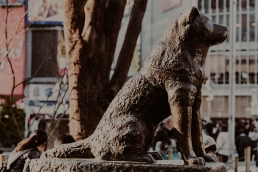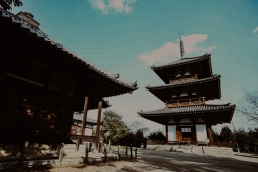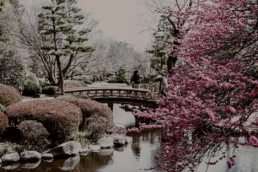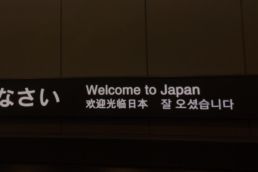Bandai Namco: il paradiso di gamer e otaku
Siamo sicure al 1000% che tutti abbiate sentito parlare, o possediate, qualcosa firmato “Bandai Namco”, soprattutto se conoscete il mondo dei videogiochi, anime e manga. Se però esiste qualcuno che ancora non la conosce, ve la presentiamo noi: Bandai Namco Entertainment è una delle principali aziende del settore dell’intrattenimento con una vasta gamma di attività e una forte presenza globale. I suoi franchise iconici ("Tekken", "Soulcalibur", "Dark Souls", "Tales of", "Ace Combat", "Dragon Ball" solo per citarne alcuni) la rendono una forza dominante nel mondo gamer e otaku!


L'azienda gestisce anche numerose sale giochi e parchi a tema e, nel cuore di Akihabara, noto come il quartiere dell'elettronica e della cultura pop giapponese, sorge Namco Akihabara, conosciuto anche come Namco Namjatown: un popolare complesso di intrattenimento di 6 piani!
Namco Akihabara
Giocatori, collezionisti di action figures, carte collezionabili e amanti degli anime siete in ascolto? Bene, perchè questo è il vostro paradiso!
I primi due piani sono pieni di “claw machine” (o “crane game” ovvero gru a premi, dove è possibile afferrare il proprio premio attraverso una sorta di “zampa” ed un meccanismo della macchina): potete provare a vincere tutto ciò che vi piace trascorrendo un sacco di tempo (e soldi!!) alla caccia del premio più ambito!
Il terzo piano è dedicato ai giochi arcade tra cui otto drum machine Taiko no Tatsujin. Non vi deve proprio mancare il ritrmo e dovete saper essere pronti a sudare!



Al quarto piano resterete impressionati dalle 800 capsule toy machine targate Namco (i famosi gashapon ガシャポン) dovre potrete vincere piccoli gadgets di ogni tipo in modo totalmente casuale!
Salendo al quinto piano si apre il mondo delle carte collezionabili di Bandai e, se vi sentite ben preparati, potreste anche cimentarvi in vere e proprie battaglie di gioco di carte!
Ora però torniamo giù e scendiamo al piano seminterrato: conoscente Gundam vero? Benissimo, questo è il piano dedicato ai suoi videogiochi di cui Bandai Namco possiede i diritti! Sono disponibili 44 giochi Mobile Suit Gundam Extreme Vs 2 OverBoost, oltre a eventi speciali organizzati regolarmente.
Naturalmente l'ingresso all’enorme complesso è gratuito, con il pagamento richiesto solo per giocare a ciascun gioco.

In definitiva, Namco Akihabara è un luogo vivace e divertente che rappresenta perfettamente lo spirito di Akihabara e offre un'esperienza unica per i visitatori di Tokyo, in particolare per coloro che sono interessati alla cultura pop giapponese e all'intrattenimento… e….POTRESTE VISITARLO INSIEME A NOI!
Your Japan - vieni in Giappone con noi
Your Japan è un progetto che nasce dalle menti di Japan Italy Bridge in collaborazione con Giramondo Viaggi Grezzana e Bandai Namco. Insieme ai nostri esperti, avrete la possibilità di vivere un’esperienza unica nella città dai mille colori: Tokyo.
Una delle megalopoli più grandi al mondo dove la modernità convive con il Giappone tradizionale. Una fusione quasi perfetta che ci permette di passare dalle atmosfere zen dei giardini del Palazzo Imperiale, sino ad arrivare ai vivaci quartieri di Shinjuku ed Akihabara. Ed è proprio in quest'ultima zona che si aprono gli orizzonti a tutti gli amanti di manga e anime. Non importa quanti anni abbiate, qui è il posto giusto per trovare “vecchi” videogiochi storici, o le nuovissime uscite sul mercato. Da nomi storici come Pac-man a Dragon Ball, passando per titoli storici come Ken il Guerriero, City Hunter, i Cavalieri dello Zodiaco, sino ad arrivare a titoli più recenti come Tekken.


I nostri partner
Il marchio GiraMondo Viaggi nasce nel centro storico di Verona nel 1979 con una singola agenzia di viaggi. Con il passare degli anni, il marchio cresce, convertendosi in un gruppo, con molte agenzie di viaggi, presente sul territorio nazionale ed internazionale.
Attualmente si contano un centinaio di agenzie, con marchio GiraMondo, ciascuna con il proprio negozio e location unica in Italia e all’estero.
Leader dell'industria dell'intrattenimento mondiale, BANDAI NAMCO Entertainment Europe pubblica e distribuisce videogiochi e prodotti di intrattenimento in Europa, Medio Oriente, Africa e Asia-Pacifico. La filosofia aziendale è "More Fun For Everyone".
La missione del gruppo è di portare "più divertimento per tutti" in tutto il mondo, con l'obiettivo di diventare i leader dell'innovazione nell'intrattenimento globale.
Dal loro quartier generale europeo a Lione lavorano a titoli come pac-man, soulcalibur, tekken e dark souls… oltre a nuovi progetti come little nightmares, twin mirror e the dark pictures.
I tour leader di "Your Japan"
Il nostro pacchetto è pensato per darvi tutte le attenzioni necessarie per farvi vivere un’esperienza unica ed indimenticabile. Infatti, il nostro staff italiano vi assisterà per tutta la durata del viaggio. I nostri tour leader partiranno da Malpensa con voi e vi accompagneranno per tutta la durata del soggiorno, sino al vostro rientro in Italia.
In questi 8 giorni, il nostro staff vi porterà alla scoperta della capitale giapponese, con Experience esclusive e gite fuori porta per poter ammirare anche il Momiji, periodo dell’anno in cui avviene il cambio del foliage.
Fra alberi di Ginko, templi e grattacieli, avrete l’opportunità di vivere un’esperienza indimenticabile e soprattutto all inclusive. Il nostro pacchetto è stato proprio costruito per dare la possibilità ai viaggiatori di non dover pensare a nulla se non a godere delle bellezze di questa fantastica terra. Non dovrete quindi preoccuparvi di voli, hotel o visite guidate perchè è tutto compreso nel prezzo. Inoltre, per chi prenota entro il 30 giugno, avrà anche un ulteriore sconto di 100€ per camera.
Quindi, cosa state aspettando? È arrivata l’ora di fare la valigia e partire con noi!
I 7 giardini giapponesi più belli di Tokyo
Oasi di pace
Normalmente quando pensiamo alla parola “città” ci vengono in mente immagini di strade, case, palazzi, grattaceli, caos, traffico e difficilmente immaginiamo grandi parchi verdi. Alle volte questo è un grande errore perchè molte città nascondono invece oasi di tranquillità proprio nel cuore della loro vivacità. Tokyo ne è un esempio: numerosi nihon teien (giardini giapponesi) rendono la metropoli un piccolo paradiso di serenità!
Il design del giardino è un’importante forma d’arte nipponica che affonda parte delle sue radici nel Buddismo Zen: la spiritualità degli elementi naturali come gli stagni e le pietre si fonde con l’ospitalità della componente scenica grazie alle ciotole per l’acqua e le case da té.
Ogni giardino ha uno scopo diverso, ma il concetto alla base è sempre uno solo: trovare la solitudine come elemento essenziale di pace interiore e ammirare il susseguirsi delle quattro stagioni. Proviamo ora a visitarne 7, i più belli per immergerci in un’armonia di colori che solo la natura ci può regalare.

Photo Credits: flickr.com
1- Koishikawa Korakuen
Situato vicino alla stazione di Iidabashi, questo giardino è un'opera d'arte vivente: progettato secondo il principio della “miniaturizzazione” che cerca di ricreare paesaggi su scala ridotta, questo spazio straordinario include colline, valli, laghetti e ruscelli. “Daisensui”, il laghetto centrale, riflette il cielo e i circostanti alberi di ciliegio; il rosso “Engetsukyo”, il “ponte della luna piena”, offre una vista mozzafiato sull’intero giardino

Photo Credits: flickr.com
2- Rikugien
Situato nel quartiere di Bunkyoè uno dei pochi giardini rimasti dell’era Edo. Il nome “Rikugien” significa “giardino dei sei principi”, riferendosi alle sei scuole di poesia giapponese che ispirano il suo design. Durante la primavera, i ciliegi in fiore creano una vista mozzafiato, mentre in autunno le foglie cambiano colore, trasformando il giardino in una tavolozza di tonalità rosse, gialle e arancioni.

Photo Credits: flickr.com
3- Hamarikyu Gardens
Posizionato vicino alla baia di Tokyo. il giardino è progettato in stile "kaiyu-shiki teien", un tipo di giardino giapponese che prevede un percorso circolare intorno a un laghetto centrale “Shioiri”, il quale è collegato alla baia di Tokyo e subisce le maree ed il piccolo padiglione di tè Nakajima-no-Ochaya, situato su un'isola nel laghetto. Sul ponte di legno si gode di una vista spettacolare sul giardino e sulla moderna architettura urbana.

Photo Credits: flickr.com
4- Shinjuku Gyoen
Questo giardino è un'oasi di tranquillità nel frenetico quartiere di Shinjuku. Offre una vasta gamma di paesaggi, tra cui giardini giapponesi tradizionali, giardini paesaggistici occidentali (inglesi e francesi) e ampie distese di prati.

Photo Credits: flickr.com
5- Gardens of the Imperial Palace
Noti anche come East Gardens, I giardini circostanti il Palazzo Imperiale sono aperti al pubblico durante tutto l'anno e offrono una visione della natura ben curata nel cuore di Tokyo
 Photo Credits: flickr.com
Photo Credits: flickr.com
6- Kiyosumi Teien
Situato nel quartiere di Kiyosumi, questo giardino è noto per la sua bellezza serena e per i suoi elementi unici, tra cui una cascata artificiale ed un laghetto di carpe koi attorno al quale sono disposte delle pietre proveniente dalla raccolta in tutto il Giappone da parte del fondatore di Mitsubishi Iwasaki Yataro. Diversi “isowatari” , grandi trampolini di lancio, sono posizionati nelle parti meno profonde dello stagno dove è possibile ammirare i riflessi degli alberi sull'acqua.
 Photo Credits: flickr.com
Photo Credits: flickr.com
7- Nezu Museum Garden
Il giardino è stato creato insieme al museo nel 1940 dal collezionista d'arte Nezu Kaichirō, Jr. Come una delle principali istituzioni culturali di Tokyo. il Nezu Museum e il suo giardino offrono una riflessione della storia e della cultura giapponese.
 Photo Credits: flickr.com
Photo Credits: flickr.com
Esplorare questi giardini è un modo meraviglioso per scoprire la bellezza e la tranquillità che si trovano nascoste tra i grattacieli e le strade affollate di Tokyo: vi suggeriamo sempre di guardarvi intorno perchè spesso le perle nascoste necessitano di attenzione per essere scovate, ma non ve ne pentirete di certo! Godetevi una fuga tranquilla e rinfrescante dal caos della vita urbana.
Yamanote Line: 10 segreti e curiosità da scoprire
Yamanote Line: Ieri e oggi, un destino imprescindibile
Si lo so, quando si parla di storia qualcuno potrebbe storcere il naso e pensare che sarà noioso quello che stiamo per dire, ma abbiate fiducia in noi e continuate a leggere…
La Yamanote Line di Tokyo è una delle linee ferroviarie più importanti e trafficate della città.
Fu aperta nel 1885 dalla società ferroviaria privata Nippon Railway Company. Originariamente, la linea faceva il giro intorno al centro di Tokyo, collegando le principali stazioni ferroviarie della città ed era conosciuta anche come “La via della seta”. Nel corso degli anni, la linea subì diverse estensioni e modifiche per soddisfare la crescente domanda di trasporto nella capitale giapponese diventando un pilastro del trasporto pubblico di Tokyo, giocando un ruolo vitale nel collegare le diverse aree della metropoli.
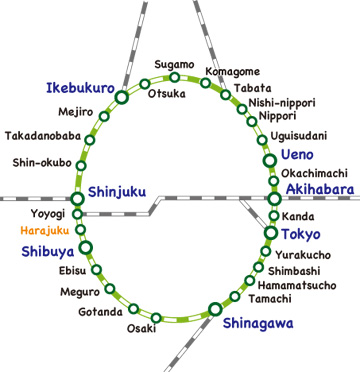
Photo Credits: https://www.gov-online.go.jp/
Oggi, la Yamanote Line è gestita dalla East Japan Railway Company (JR East) e continua a essere una delle linee ferroviarie più affollate del mondo, trasportando milioni di passeggeri ogni giorno attraverso i quartieri più importanti di Tokyo, come Shibuya, Shinjuku, Ikebukuro e Ueno. La Yamanote Line è diventata un'icona della vita quotidiana a Tokyo e uno dei simboli del sistema ferroviario giapponese altamente efficiente e affidabile.
Yamanote Line: Segreti e Curiosità
Grazie alla Yamanote Line è possibile raggiungere 30 quartieri di Tokyo ed è un vero e proprio tesoro di segreti e curiosità! Saliamo a bordo e scopriamo insieme 10 tappe imperdibili!
 Photo Credits: flickr.com
Photo Credits: flickr.com
1 - Shin-Okubo
Questa stazione è nota come la "piccola Corea" di Tokyo, con una vasta gamma di negozi, ristoranti e caffè che offrono cibo e cultura coreana.
2 - Meguro River Cherry Blossoms
Durante la stagione dei fiori di ciliegio, il tratto del fiume Meguro vicino all’omonima stazione si trasforma in un paradiso di petali rosa.
3 - Nishi-Nippori Yanaka Ginza
Questa piccola via commerciale vicino a Nishi-Nippori è un'oasi di negozi tradizionali e ristoranti rustici che offrono una prospettiva autentica della vita quotidiana a Tokyo.
4 - Sugamo
Conosciuto come il "Harajuku per anziani", Sugamo è popolare tra gli anziani per i suoi negozi che vendono prodotti tradizionali giapponesi e per il tempio Koganji, famoso per la sua pietra della fortuna rossa.
5 - Yūrakuchō Gado-shita
Sotto le tracce della Yamanote a Yūrakuchō si trova un labirinto di piccoli bar e ristoranti chiamato "Gado-shita", che offre un'atmosfera unica e vivace.
6 - Akihabara
Nota come la mecca della cultura otaku, Akihabara è piena di negozi di anime, manga, elettronica e caffè a tema.
7 - Komagome
Questo quartiere è famoso per il giardino Rikugien, uno dei più belli di Tokyo, che offre paesaggi incantevoli in ogni stagione.
8 - Shibuya Crossing View from Starbucks
Mentre Shibuya Crossing è un punto caldo per i turisti, pochi sanno che il Starbucks vicino alla stazione offre una vista panoramica perfetta per osservare il caos urbano di Tokyo dall'alto.
9 - Iidabashi e Koishikawa Korakuen
Questa stazione è vicina al bellissimo giardino giapponese di Koishikawa Korakuen, un'oasi di tranquillità nel cuore di Tokyo.
10 - Meiji Shrine Gyoen
Non lontano dalla stazione di Harajuku, il vasto parco intorno al Santuario Meiji è un luogo ideale per una passeggiata rilassante lontano dal trambusto della città.
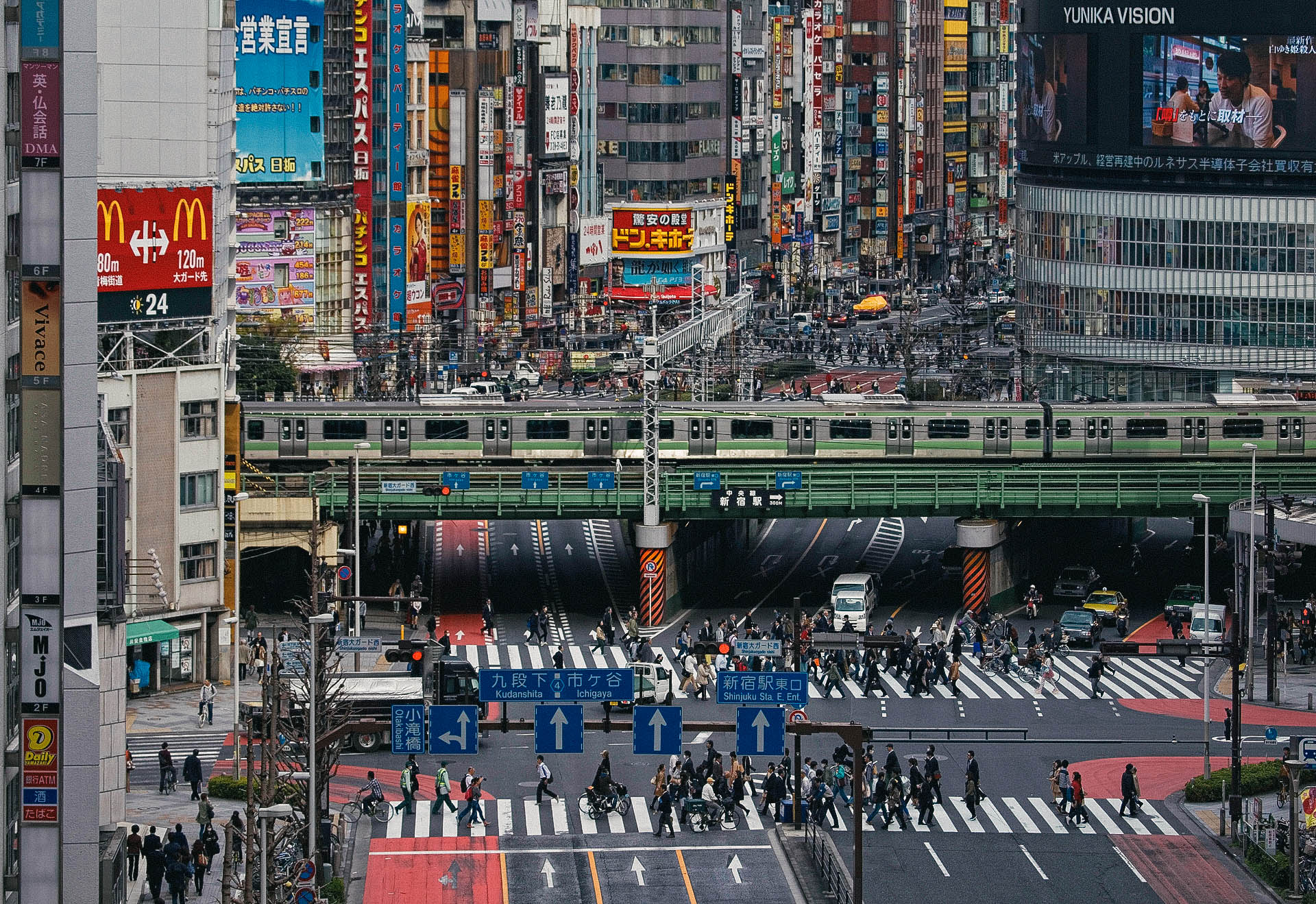 Photo Credits: flickr.com
Photo Credits: flickr.com
Che dite, saliamo a bordo della prossima fermata e andiamo insieme alla scoperta di nuovi luoghi?
Dieci cose che non si sanno su Hachiko
Tutti, ma proprio tutti conoscono la storia del fedele Hachiko, il cane che negli anni 30 commosse i cuori di tutto il mondo per la sua fedeltà profonda, non tutti però conoscono alcuni particolari su questo dolce cane la cui statua simbolo si erge a Shibuya.
10 cose che non si sanno su Hachiko
Autore: Sara

photo credits: lastampa.it
1- Le Origini
Il bellissimo Akita-inu nacque nel 1923 a Odate nella prefettura di Akita (da cui deriva il nome della razza, “cane di Akita”) e venne acquistato dallo scienziato Hidesaburo Ueno che lo chiamò Hachi, “8”. Proprio ad Odate, di fronte alla stazione, si trova un’altra statua di Hachi un santuario e il museo Akitainu Hozonkai.

photo credits: keblog.it
2- L’amore che vince la cattiveria
Quando Ueno morì nel 1925, Hachi trovò una nuova sistemazione presso l’ex giardiniere dello scienziato, Kikuzaburo Kobayashi a Tomigaya, poco lontano da Shibuya. Ogni giorno il fedele cane si recava così alla stazione di Shibuya ad attendere il ritorno di Ueno, ma per 10 anni questa “passeggiata” non fu sempre tranquilla: Hachiko venne maltrattato e picchiato svariate volte da pedoni, bambini e persone prive di una qualsivoglia umanità. Vergognoso, non è vero?

photo credits: greenme.it
3- Hachi diventa Hachiko
Nel 1932 il presidente della Nihon Ken Hozonkai, associazione per la conservazione del cane giapponese, Hirokichi Saito venne a conoscenza della storia di Hachi e scrisse un articolo raccontando le peripezie e i maltrattamenti subiti da questo fedele cane trasformandolo in breve tempo in un simbolo. Fu a questo punto che venne aggiunto il suffisso “ko” al nome di Hachi per dimostrare rispetto per la sua devozione e lealtà.
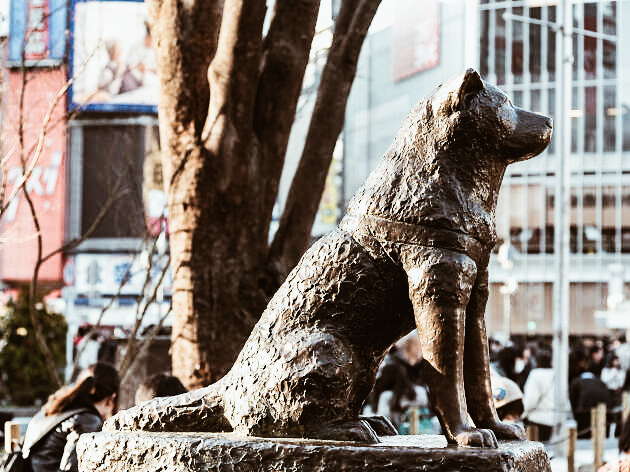
photo credits: hotcorn.com
4- La Statua onorifica
Teru Ando, conoscente di Saito, scolpì la famosa statua di Hachiko (mentre il cane era ancora in vita!) che venne inaugurata nel 1934. Prima che ciò avvenisse numerosi truffatori tentarono di spillare soldi sostenendo di essere loro i creatori della statua! Non c’è davvero mai limite all’avidità umana…

photo credits: japantravel.com
5- La Fusione delle Statue
La Seconda Guerra Mondiale non risparmiò nulla, nemmeno le statue di Hachiko. Il metallo con il quale erano costruite doveva essere impiegato “per il bene della guerra” e quindi vennero fuse.
Alla fine della guerra del Pacifico il figlio di Ando, Takeshi, costruì l’attuale statua a Shibuya. Anche quella alla stazione di Odate venne ricostruita nel 1967.
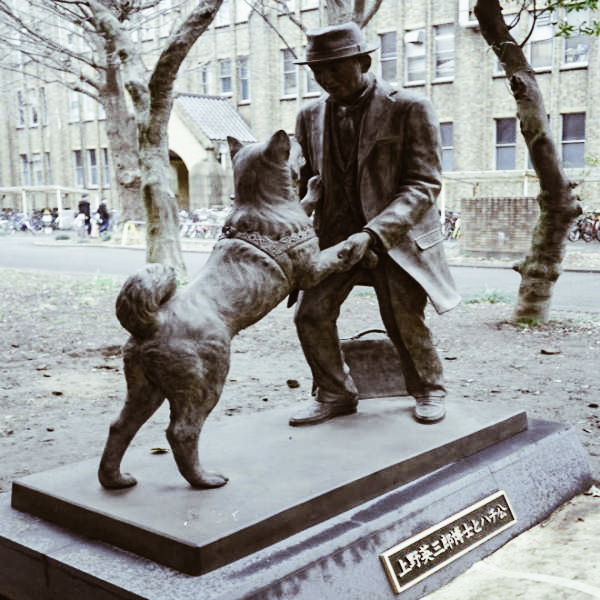
photo credits: animalpedia.it
6- Hachiko e Ueno per sempre insieme
Fin’ora abbiamo sempre parlato delle statue dedicate al cucciolo, ma ne esiste un’altra, bellissima, che riunisce Hachiko ed il suo padrone. Fu costruita 80 anni dopo la morte di Hachiko, quando l’università di Tokyo decise di rendere omaggio ai due protagonisti della triste storia. Grazie alla donazioni provenienti da privati ed aziende, oltre 10 milioni di yen hanno reso possibile la riunione tra il cane ed il suo padrone. Oggi la statua sorge nel campus dell'Università di Tokyo, proprio accanto al Parco Ueno.
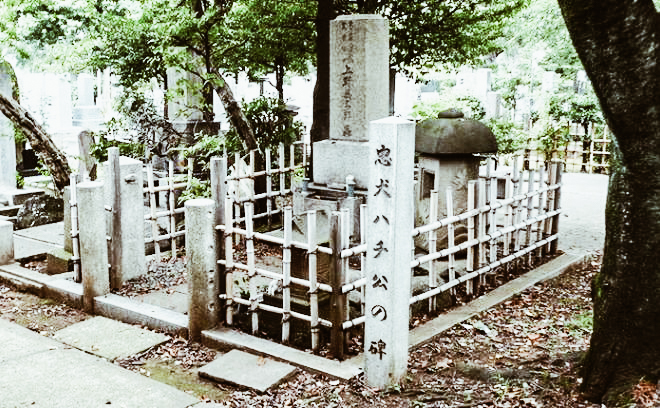
photo credits: womanuntamed.com
7- Un Cimitero ricco di fascino
Credo di essere tra i pochi che adorano visitare i cimiteri e quello di Aoyama, risalente al 1872, si colloca sicuramente tra i più belli: vicino alle stazioni di Gaienmae e Aoyama Itchome, si estende come se fosse un immenso parco ed ospita numerosi personaggi famosi le cui pietre tombali si ergono svelando un’architettura unica. Naturalmente Ueno giace proprio qui ed accanto alla sua tomba vi è un monumento eretto subito dopo la morte di Hachiko nel 1935.

photo credits: wikimedia.org
8- Tra il macabro e la scienza
Questo punto lo definirei quasi disgustoso, ma se avete il coraggio (e lo stomaco) di ferro allora sappiate che è possibile osservare gli organi interni di Hachiko conservati in bottiglie campioni al museo dell'archivio della Facoltà di Agraria dell'Università di Tokyo, vicino al Parco Ueno. Varie autopsie eseguite tra il 1935 e il 2010 avevano riscontrato infestazioni da malattie parassitarie e, infine, un cancro, vera causa della morte di Hachi. Presso il Museo Nazionale della Natura e della Scienza esiste anche un Hachiko tassidermizzato con la pelliccia originale del cane…...

photo credits: timeout.com
9- I Protettori di Tokyo
Nel parco di Ueno si erge anche la statua del samurai Saigo Takamori con la sua fedele Tsun. Tsun e Hachiko sono divenuti presto un simbolo per i giapponesi e dichiarati i “protettori di Tokyo e dell’economia giapponese”.

photo credits: ilgiornale.it
10- Richard Gere come Ueno?
Sono sicura che tutti (o quasi) abbiano visto il film “Hachiko - Il tuo migliore amico” (Titolo originale: “Hachi: A Dog's Tale”) , ma vi siete fermati a pensare che questa pellicola del 2009 è ambientata negli Stati Uniti? La storia è comunque straziante e bellissima, ma non riesce a portare alla luce la cultura nipponica come invece riesce a fare il film originale del 1987, “Hachiko Monogatari”
Nara, la capitale del Buddhismo in Giappone
Il Giappone come l'Italia ha tantissime mete turistiche e fra queste troviamo i sette templi di Nara, una meta ricca di storia e cultura.
I 7 Templi di Nara, la capitale del Buddhismo
Autore: Sara

Chi si avvicina per la prima volta alla cultura del Sol Levante è portato a credere che il Buddhismo sia da sempre stata una filosofia strettamente nipponica anche grazie ai numerosi templi sparpagliati per il Paese. In realtà pochi sanno che fu un re coreano ad “esportare” questa religione in Giappone! Tutto iniziò quando la prefettura di Nara era il centro della politica, della cultura e dell'economia del Paese. Il popolo giapponese era prettamente shintoista cioè seguace dello "Shinto" (神道): una religione politeista di tipo animista che verte attorno all'esistenza di molti Kami ("dei", "spiriti") che si crede abitino tutte le cose. Nel 552, il re Seond di Baekje, regno sorto nel sud ovest della penisola di Corea, portò alla corte giapponese una statua di Shakyamuni (Buddha storico) e numerosi satra. L'imperatore dell'epoca, Kimmei, ne rimase attratto e lentamente il buddismo si affermò come nuova religione di Stato.
Nara divenne così Nanto Shichi Daiji (南都七大寺), la capitale dei templi buddisti costruiti su ordine imperiale, oggi patrimonio mondiale, e comprende:
- Horyuji(法隆寺)
- Houkiji (法起寺)
- Todaiji(東大寺)
- Kofukuji(興福寺)
- Gangoji (元興寺)
- Yakushiji (薬師寺)
- Toshodaiji (唐招提寺)
I sette templi di Nara
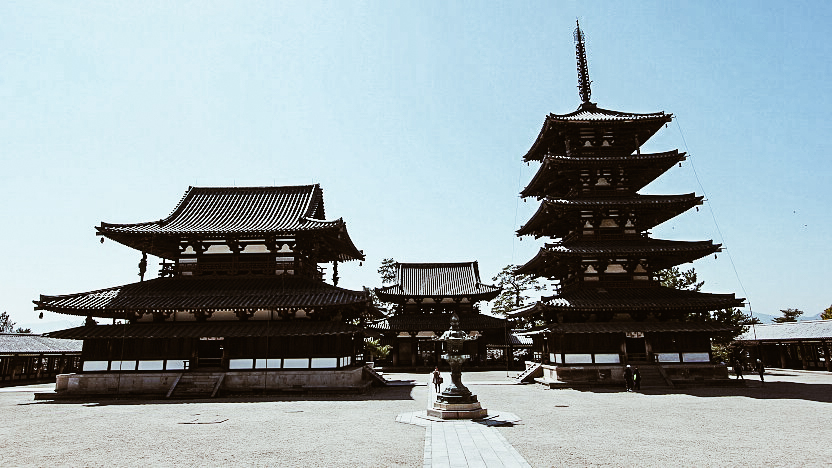
photo credits: https://www.japan-guide.com
Horyuji
Il tempio Horyuji è il primo sito ad essere stato designato patrimonio dell’UNESCO in Giappone. Fondato nel 607 dal principe Shotoku su desiderio del padre, l'imperatore Yomei, venne ricostruito nel 670 a seguito di un incendio che lo bruciò quasi completamente e oggi è considerato la culla del buddismo giapponese. La superficie sulla quale si estende il largo complesso del tempio può essere suddivisa in lato ovest, Saiin garan (西院伽藍, ove sono situate la pagoda a cinque piani, la sala d'oro, il corridoio e il portale interno) e lato est, Toin garan (東院伽藍, dove sorge l’ottagonale Yumedono (夢殿, la sala delle visioni).
Sito Ufficiale: http://www.horyuji.or.jp/assets/images/pdf/english.pdf
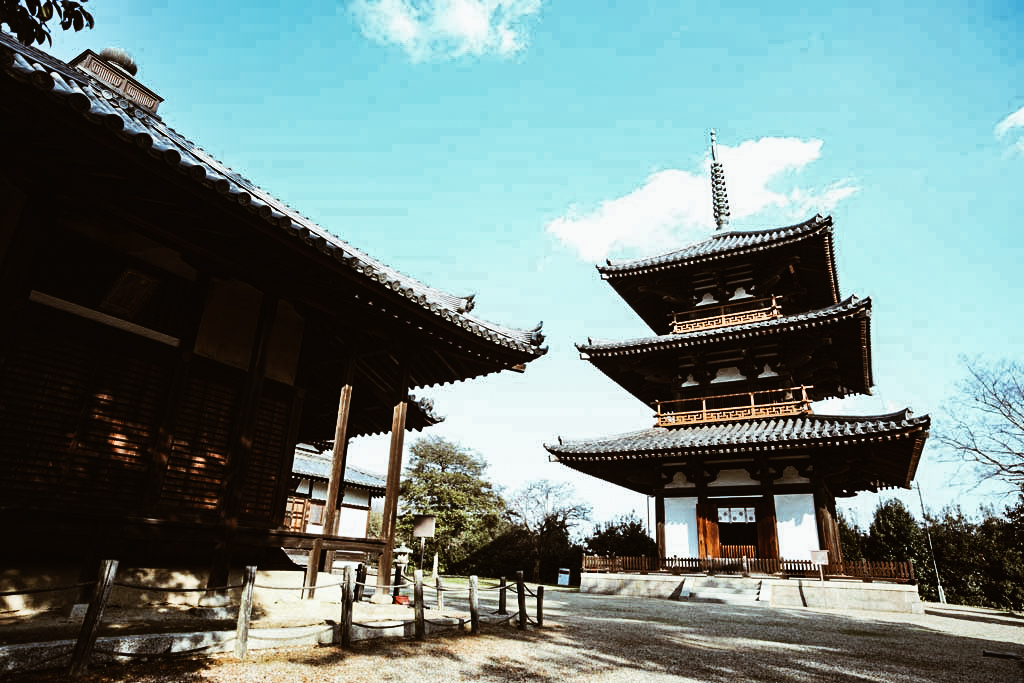
photo credits: masterpiece-of-japanese-culture.com
Houkiji
Questo tempio dalle molteplici identità (è infatti conosciuto anche come Okamoto-dera 岡本寺, Okamotoniji 岡本尼寺, Ikejiri-dera 池後寺 e Ikejiriniji 池後尼寺) sorge a poco meno di 2 km da Horyuji. Originariamente fu il palazzo della famiglia di Shotoku Taishi, ma prima di morire egli ordinò al figlio Yamashirono-ooenoo di ricostruirlo sotto forma di tempio. Houkiji è costituito da una sala principale ed una pagoda a 3 piani, alta circa 23 metri: la più grande e antica del suo genere in Giappone (fu costruita nel 685). Un simbolo di questo tempio è senza dubbio il Kannon di legno a 11 teste e il Bosatsu di bronzo (entrambi dei della compassione)
Sito Ufficiale: http://www.horyuji.or.jp/assets/images/pdf/english.pdf

photo credits: shoreexcursions.asia
Todaiji
Todaiji fu fondato dall’imperatore Shomu nel 752, con il mero scopo di ospitare la statua del Grande Buddha nella Grande Sala (Daibutsuden). Dopo 7 lunghi anni di realizzazione, il tempio fu bruciato a seguito della guerra nel 1180 e continuò a subire le conseguenze dei conflitti fino al 1567. Restaurato ogni volta, la forma attuale del tempio risale al 1709 ed il suo Buddha seduto rappresenta Vairocana ed è fiancheggiato da due Bodhisattva. I terreni del tempio si estendono per quasi tutta la parte settentrionale del parco nazionale di Nara: per questo motivo non è raro imbattersi nei famosi cervi in cerca di attenzione!
Sito Ufficiale: http://www.todaiji.or.jp/english/index.html
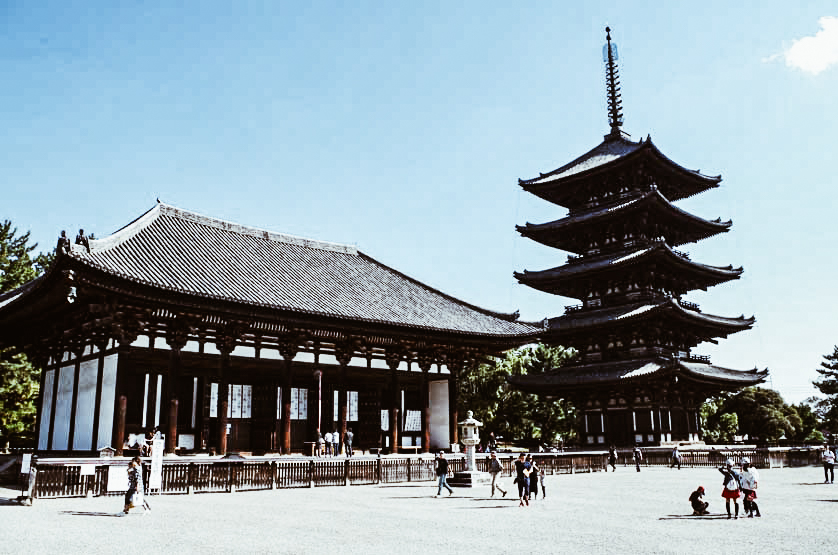
photo credits: japanvisitor.com
Kofukuji
Kofukuji era originariamente il tempio del potente clan Fujiwara e uno dei templi principali della setta Hosso (法相宗), una delle sei sette di Nanto. Il tempio è costituito da diversi edifici di importante valore storico e ben due pagode: una di cinque piani e una di tre piani, che purtroppo non possono essere visitate. A supplire questa mancanza però, c’è il Museo del Tesoro Nazionale nel quale è possibile ammirare la statua di Ashura e la testa di bronzo di Buddha.
Sito Ufficiale: https://www.kohfukuji.com/english.html
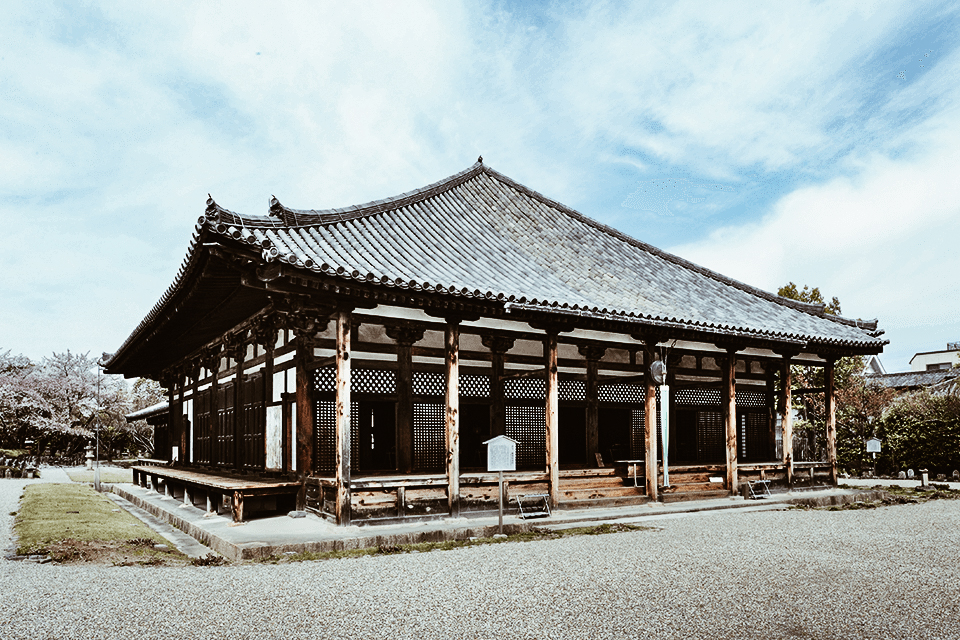
photo credits: kintetsu.co.jp
Gangoji
Fondato da Soga no Umako, Gangoji è tra i più antichi templi del Giappone, essendo stato trasferito da Asuka a Nara nel 718. Quasi come una tetra tradizione, anche questo tempio subì l’ira della natura e la devastazione del fuoco e nel 1451 quasi tutta la struttura venne distrutta e non fu più possibile recuperare l’antico splendore di Gangoji se non per la sala Zenshitsu, posta sul retro, unica superstite originaria.
Sito Ufficiale: https://gangoji-tera.or.jp/

photo credits: japan-guide.com/
Yakushiji
Esattamente come Kofukuji, anche Yakushiji è il tempio principale della setta Hosso del buddismo. Fu costruito dall’imperatore Tenmu per sua moglie nel 680. Come ogni tempio, anche questa volta troviamo una grande statua del Buddha: in questo caso Yakushi-Nyorai possiede il potere della guarigione ed è in grado di dare conforto. Inoltre Yakushiji possiede due pagode, una sala dorata ed una collezione di oggetti d'arte buddista, tra cui una Triade Yakushi, un Kannon-Sho e dipinti di grande pregio
Sito Ufficiale: http://www.nara-yakushiji.com/
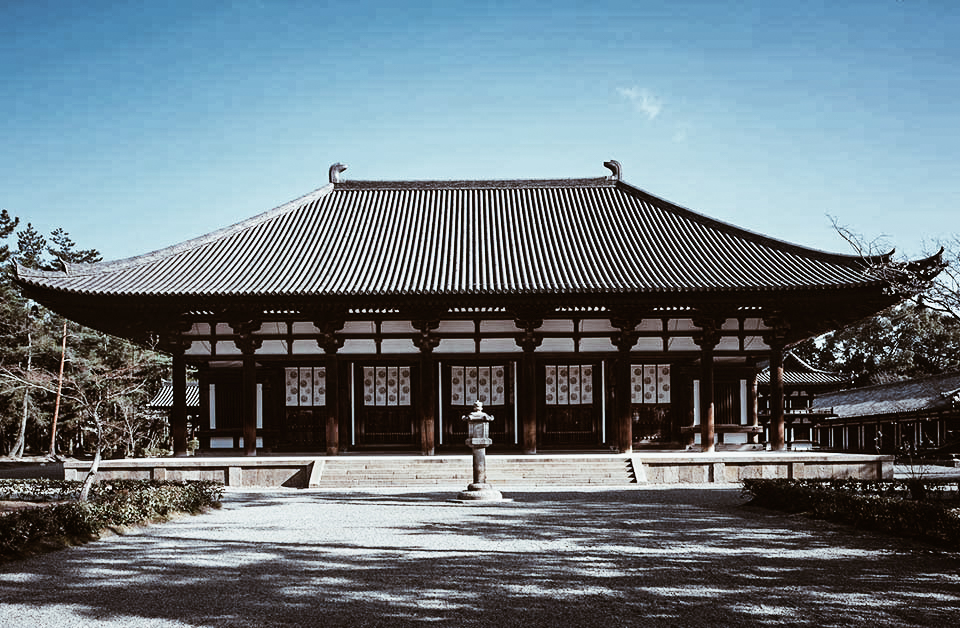
photo credits: toshodaiji.jp/
Toshodaiji
Toshodaiji è stato il primo tempio fondato nel 759 da un sacerdote cinese, Ganjin, che venne inviato dall’imperatore con lo scopo di insegnare ai sacerdoti e migliorare il buddismo in Giappone. I suoi insegnamenti ebbero una grande influenza per il Paese ed oggi è il tempio principale della setta Rishu (律宗). La sala principale, Kondo, contiene ben 9 statue di Buddha!
Sito ufficiale: https://www.toshodaiji.jp/english/index.html
7 Templi, 7 affascinanti meraviglie dedicate alla cura dell’anima: nonostante possano sembrare estremamente simili tra loro, ogni costruzione è caratterizzata da elementi unici e preziosi da scoprire ed ammirare! Che ne dite di dedicare un po’ del vostro tempo a passeggiare per Nara alla scoperta di questi luoghi devoti? Ci siete già stati? Fateci sapere le vostre impressioni ed emozioni!
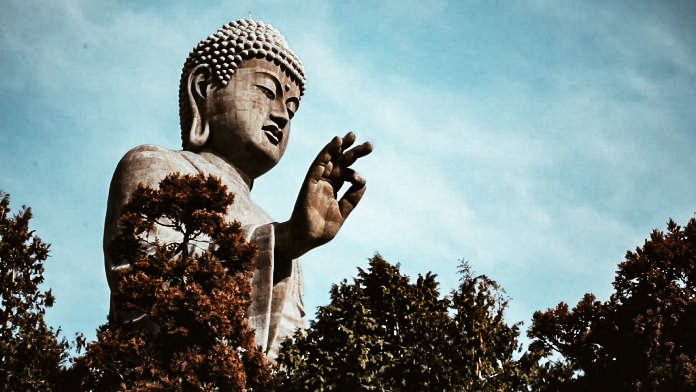
photo credits: thejapanesedreams.com
I meravigliosi giardini del Giappone
Con Japan Italy Bridge abbiamo già affrontato un deep focus sul Palazzo Imperiale e i suoi giardini, ma quelli non sono gli unici giardini del Giappone. Oggi vi parleremo degli spazi verdi più belli del Sol Levante.
Giardini del Giappone, il verde in mezzo alla modernità
Autore: Sara

photo credits: giardiniepiscine.it
Ogni Paese del mondo per quanto evoluto, tecnologico e caotico sia, nasconde sempre un’oasi di pace straordinaria, un luogo dove la mano dell’uomo non ha distrutto, ma piuttosto si prende cura di bellezze naturali dal fascino indescrivibile. Non parliamo dei parchi naturali questa volta, ma di ritagli di verde più piccoli come i giardini. Spazi verdi che sorgono in luoghi inaspettati e che regalano alla mente e all’anima una pausa da tutto ciò che è macchine-grattacieli-cemento e che, anche in questo caso, il Giappone sa regalarci con la sua solita eleganza e quel tocco spirituale unico nel suo genere.
Il viaggio che vi proponiamo oggi vi farà rilassare, che ne dite quindi di mettervi comodi, di prepararvi una deliziosa tisana e di seguirci?
Kenrokuen
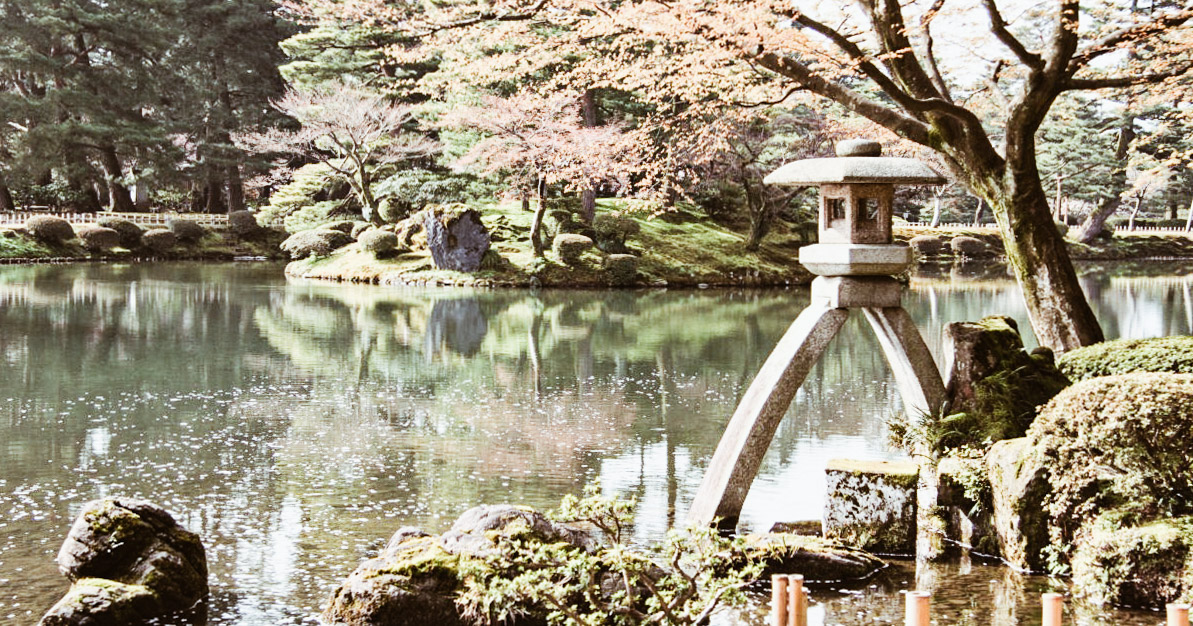
photo credits: japantravel.com
La prima delle nostre tappe è Kanazawa dove si trova il Kenrokuen che ricopre una superficie di 11,4 ettari ed è considerato uno dei giardini più belli del Sol Levante. Mantenuto rigoglioso di generazione in generazione dalla famiglia Maeda fin dal periodo feudale, in giapponese il nome Kenrokuen significa “giardino dei 6 attributi” perchè in esso sono racchiude le 6 caratteristiche del giardino perfetto: spazio, tranquillità, artificio, antichità, corsi d’acqua e panorami.
Official Web Site: pref.ishikawa.jp
Korakuen
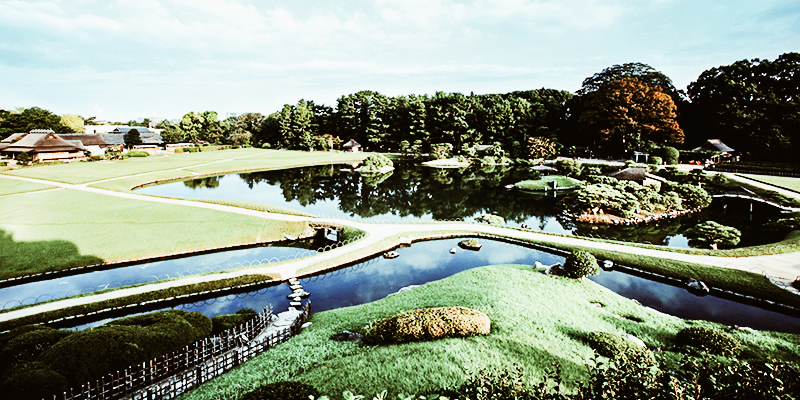
photo credits: okayama-kanko.net
La seconda tappa ci porta a Okayama, dove il magnifico Korakuen sorge: costruito nel 1687 esclusivamente come luogo di intrattenimento per la famiglia dominante, fu aperto al pubblico nel 1884, quando divenne proprietà della prefettura di Okayama. Esso racchiude boschi, campi di té e riso, uno spettacolare stagno e tanti piccoli ruscelli.
Official Web Site: okayama-korakuen.jp
Giardini del Giappone: Kairakuen
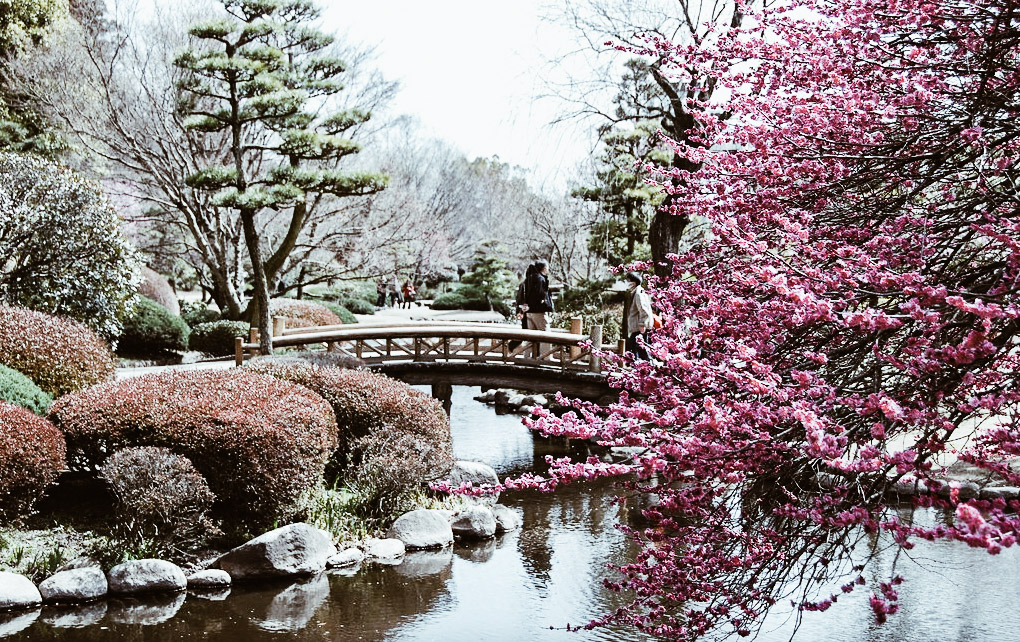
photo credits: flickr.com
Siamo giunti al terzo tra i più bei giardini paesaggistici del Giappone, ci troviamo a Mito, la capitale della Prefettura di Ibaraki e qui Kairakuen fu da sempre luogo di accesso a tutti, non solo per il signore locale Tokugawa Nariaki che lo fece costruire nel 1841. Questo splendido spazio verde è diventato famoso grazie al Mito Ume Matsuri, il festival dei prugni in fiore, che si tiene tra febbraio e marzo: uno spettacolo dal fascino intramontabile.
Official Web Site: ibaraki-kairakuen.jp
Kokedera

photo credits: saihoji-kokedera.com
La nostra quarta visita si terrà a Kyoto, al giardino che ospita 120 tipi di muschio diversi! E’ il Kokedera o Saihoji Temple, originariamente parte di una villa reale è divenuto un tempio quasi 1000 anni fa ed oggi è considerato un patrimonio mondiale dell'UNESCO. Visitare questo luogo offre anche un’opportunità unica, poiché prima di poter accedervi i visitatori devono partecipare al kito (canto) e al shakyo (la copia delle scritture buddiste).
Official Web Site: saihoji-kokedera.com
Giardini del Giappone: Shinjuku Gyoen
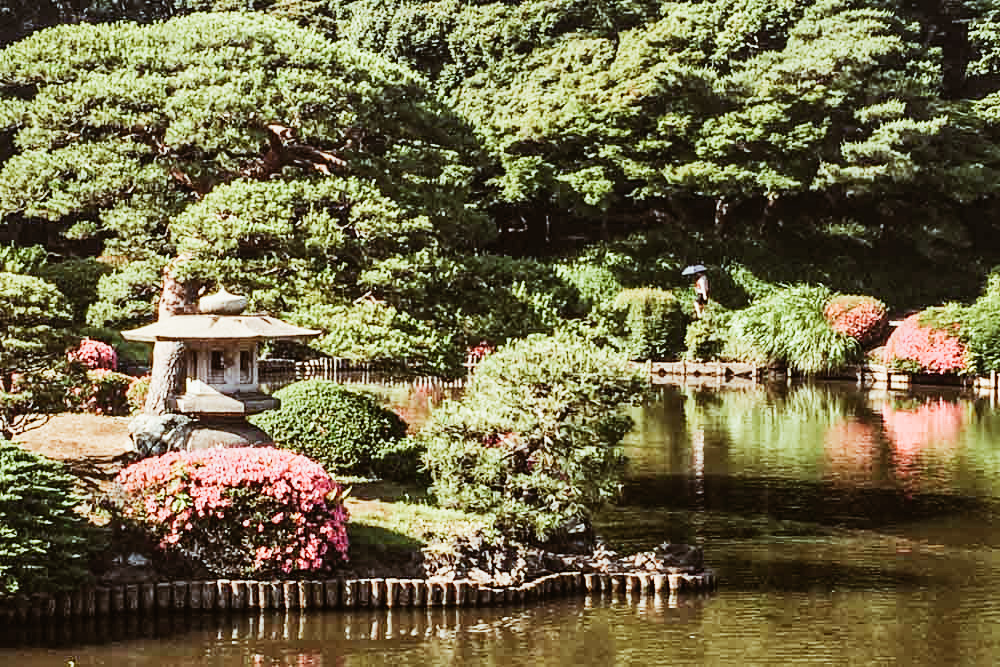
photo credits: www.japanistry.com
Per la nostra quinta tappa voliamo direttamente nella bella Tokyo dove possiamo imbatterci nello Shinjuku Gyoen National Garden, uno dei parchi nazionali più suggestivi del Paese. Costruito nel periodo Edo come residenza privata del signore feudale Kiyonari Naito è diventato luogo aperto al pubblico nel 1949. Al suo interno ci si può immergere in vari giardini, primo tra tutti il più antico quello giapponese ricco di laghi, isolette, ponti e padiglioni. Dopodiché ci si può perdere nel magnifico roseto del giardino alla francese e, non ultimo, addentrarsi nel giardino all'inglese con i suoi ampi prati verdi costeggiati da splendidi ciliegi: qui l'Hanami acquista una magia indescrivibile!
Official Web Site: env.go.jp
Giardini Est del Palazzo Imperiale
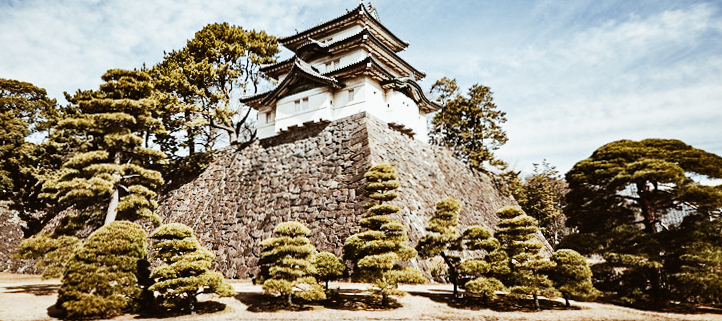
photo credits: enjoy.vivi.city
Concludiamo il nostro percorso naturale restando a Tokyo. Oltre 210.000 metri quadrati in cui, un tempo, sorgevano le mura del Castello di Edo, residenza dello shogun Tokugawa che governò il Giappone dal il 1603 al 1867. Ai piedi della collina, esattamente dove prima si ergevano le mura difensive, si stende questo meraviglioso giardino in cui lo stagno Ninomaru ospita alcune piante acquatiche piuttosto rare ed è ricoperto di Nuphar Japonicum, ninfee gialle.
Official Web Site: https://www.kunaicho.go.jp
Giappone meta preferita per chi si vuole trasferire all'estero
Il fascino senza tempo, le opportunità che offre, la frenesia delle sue città e la grandezza delle stesse eleggono il Giappone come la destinazione preferita per tutti coloro che decidono di trasferirsi all’estero per vivere e lavorare.
Giappone meta preferita per chi si vuole trasferire all'estero
Autore: Sara
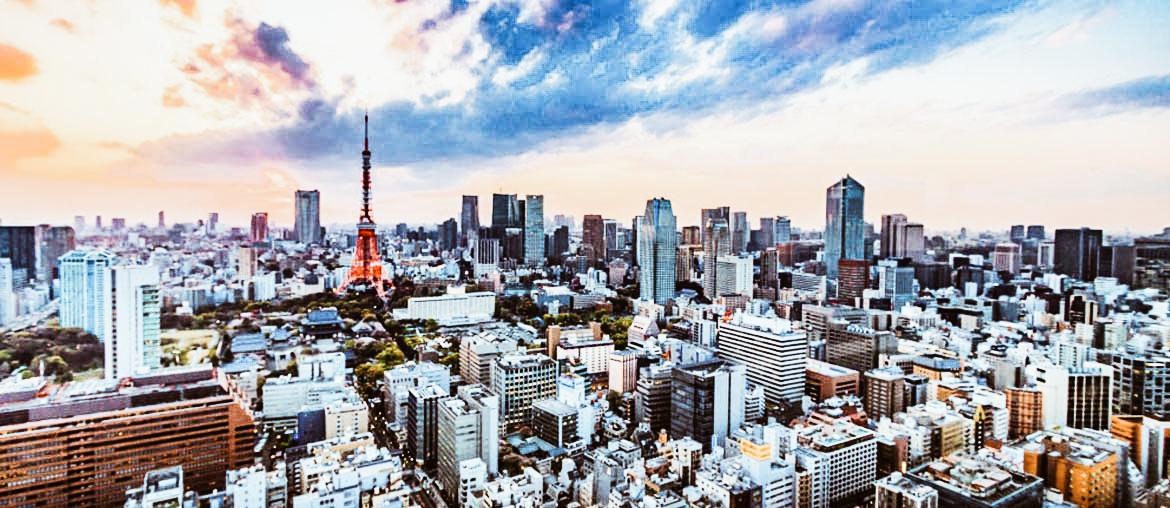
photo credits: tokeet.com
Secondo una ricerca globale, Tokyo spicca tra le 5 città al mondo scelte per intraprendere una nuova esperienza di vita. Lavorare in Giappone pare essere diventata l’aspirazione di molti, secondo una recente classifica di Remitly , società inglese che si occupa di offrire un servizio globale di trasferimento digitale di denaro per aiutare tutti gli immigrati nel mondo che fanno grandi sacrifici per vivere e lavorare in un altro paese, il numero di coloro che scelgono il Sol Levante come meta per cambiare vita è sorprendentemente elevato, persino in questo periodo di pandemia.
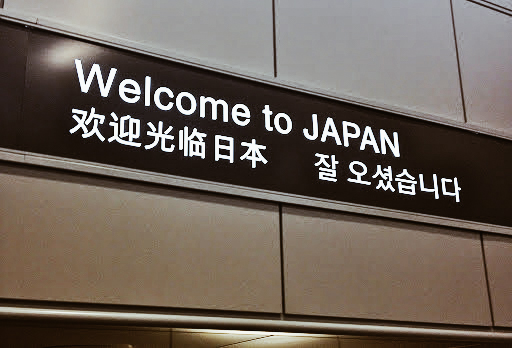
photo credits: travelwithvik.com
Le ricerche online parlano chiaro: il Giappone è il secondo paese al mondo in cui tutti vogliono trasferirsi subito dopo il Canada! Per la maggior parte i dati provengono soprattutto da Paesi specifici come Stati Uniti, Australia, Thailandia, Laos, Myanmar, Indonesia, Cambogia e Filippine.
Ad aumentare il desiderio di cambiare vita guardando alla Terra dei Samurai come meta è anche l’alto grado di sicurezza, bellezza e cultura. Del resto lo abbiamo potuto constatare in questo ultimo anno: la risposta del Giappone alla pandemia, la sua rigorosa condotta nella messa in Stato di Emergenza evitando panico e disinformazione nei confronti della popolazione, non ha fatto altro che aumentare il desiderio di fare la grande mossa e “tentare la sorte” in una delle magnifiche regioni di questa immensa isola.

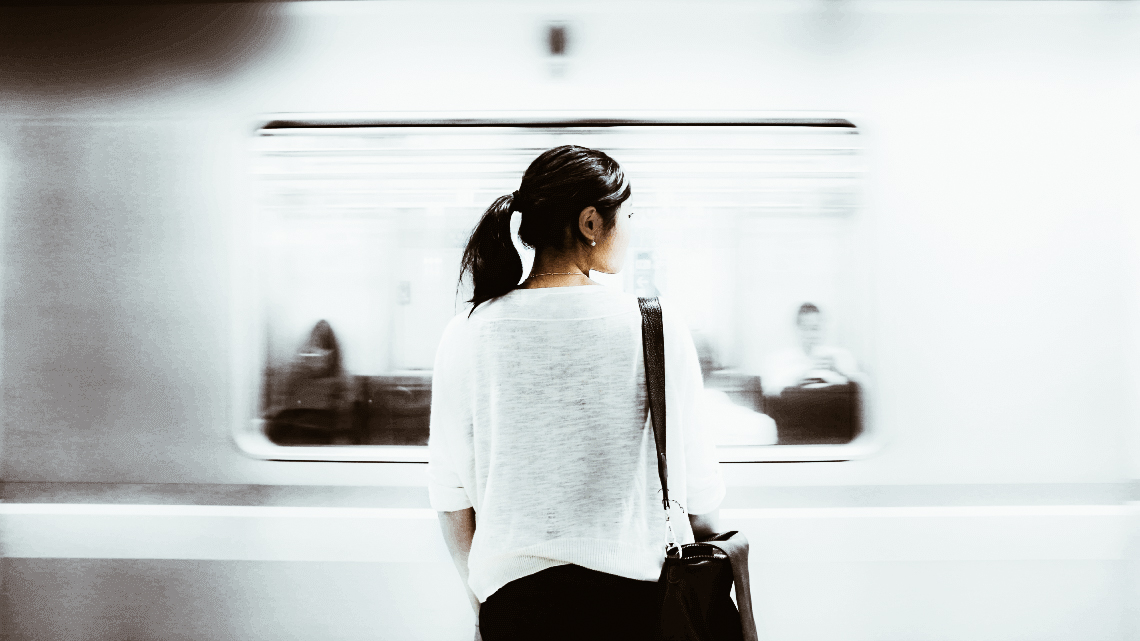
photo credits: transferwise.com, boutiquejapan.com
Voi cosa ne pensate? Fareste il “grande salto” ? Anche per voi il Giappone è la meta prescelta oppure ci sono altri Paesi verso i quali state puntando? Fatecelo sapere! E comunque sia, vi auguriamo di realizzare ogni vostro sogno al più presto, 頑張ってください!
Artisti giapponesi contemporanei all'estero
Il Giappone come l’Italia è un paese molto legato all’arte e tanti artisti contemporanei giapponesi hanno esportato i loro lavori all’estero.
Gli artisti contemporanei giapponesi all’estero
Autore: Sara
Biennali, fiere dell'arte ed expo hanno permesso al mondo dell'arte contemporanea giapponese di volgere uno sguardo verso l'esterno. Finalmente, anche i grandi artisti escono al di fuori dei confini del Sol Levante. Noi di Japan Italy Bridge abbiamo deciso di presentarvi alcuni tra i più importanti artisti contemporanei che hanno ricevuto consensi in tutto il mondo. Parliamo di creativi come Yayoi Kusama, Tatsuo Miyajima, Takashi Murakami, Yoshitomo Nara e Hiroshi Sugimoto. Siete pronti per questo viaggio?
Yayoi Kusama

photo credits: wsj.com
Nata a Nagano nel 1929, Yayoi Kusama è forse la più conosciuta fra gli artisti contemporanei giapponesi. Cominciò a dare prova delle sue immense doti artistiche a 10 anni. Il difficile rapporto con la madre ed un trauma che la segnò profondamente condussero Kusama a dipingere sulle tele le sue esperienze. L'ambiente fisico e la sua personalità svanivano inghiotte dallo spazio che si muoveva ad una incredibile velocità. Iniziò ad ispirarsi anche a Georgia O'Keeffe e le scrisse una lettera. L'artista rispose e Kusama si trasferì a New York dove iniziò a realizzare dipinti monocromatici che attirarono immediatamente l'attenzione.
I primi anni '60 non erano di certo facili per una donna, soprattutto giapponese e riuscire ad esporre nelle gallerie era un'impresa difficile. Tuttavia, ci riuscì diventando via via sempre più conosciuta nel campo dell'arte concettuale. Le sue opere includono attributi di femminismo, minimalismo, surrealismo, art brut, pop art ed espressionismo astratto accomunati tutti dalla tecnica dei pois.
Tornata in Giappone, l'artista potè godere del successo meritato. Le sue opere furono esposte al Museum of Modern Art di New York, al Tate Modern a Londra e al National Museum of Modern Art di Tokyo. Tra il 1994 e il 2012, Kusama collaborò con il musicista Peter Gabriel e soprattutto con Marc Jacobs, direttore artistico di Louis Vuitton. Kusama oggi vive nell'ospedale psichiatrico Seiwa, in Giappone, per scelta personale e continua a dipingere quotidianamente nel suo studio a Shinjuku.
Tatsuo Miyajima

photo credits: smh.com.au
Nato a Tokyo nel 1957, Tatsuo Miyajima si è laureato al corso di pittura a olio presso il dipartimento di Belle Arti della Tokyo National University of Fine Arts and Music. Iniziò a sperimentare con la performance art prima di passare alle installazioni basate sulla luce.
Miyajima affermò che il desiderio di creare un lavoro più duraturo, in contrasto con la natura necessariamente effimera della sua performance e delle sue azioni, lo ha motivato a iniziare a lavorare su sculture e installazioni. Impiegando materiali contemporanei come circuiti elettrici, video e computer, i lavori estremamente tecnologici di Miyajima si sono incentrati sull’utilizzo di contatori a diodi digitali ad emissione di luce (LED). Questi numeri, lampeggianti in cicli continui e ripetitivi da 1 a 9, rappresentano il viaggio dalla vita alla morte, la cui finalità è simbolizzata dallo "0", numero che non compare mai nella sua opera.
Miyajima ha tenuto mostre personali presso l'Ullens Center for Contemporary Art di Pechino, al Miyanomori Art Museum di Hokkaido, al San Francisco Museum of Modern Art. Inoltre, ha partecipato alla Biennale di Venezia e a numerose mostre collettive, dal Museum of Contemporary Art di Sydney, all'Hiroshima City Museum of Contemporary Art. Dal 2006 Miyajima ricopre il ruolo di vicepresidente della Tohoku University of Art and Design.
Takashi Murakami
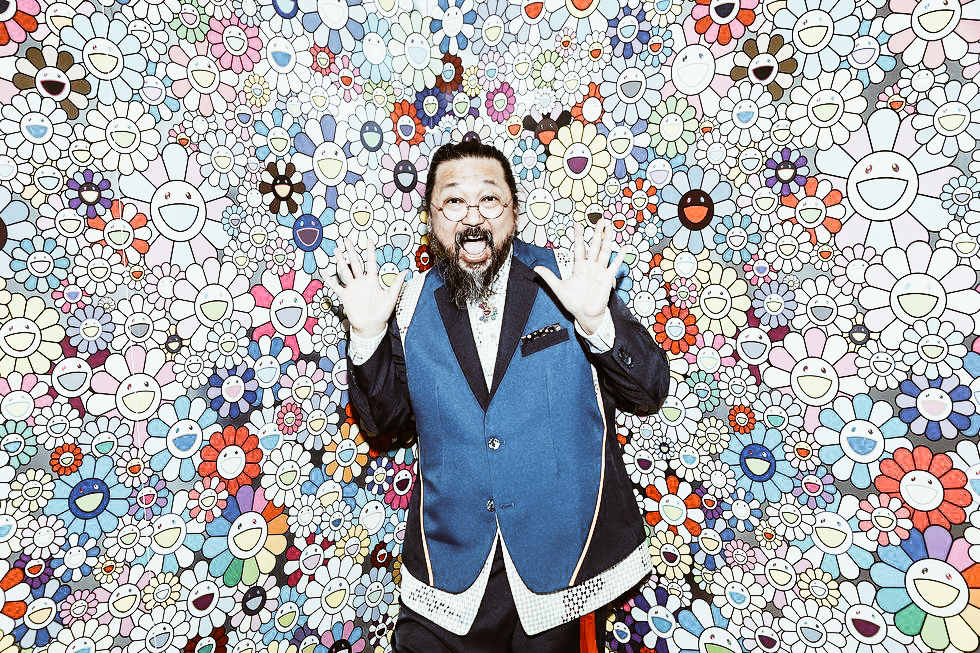
photo credits: crfashionbook.com
Nato a Tokyo nel 1962, Takashi Murakami ha intrapreso gli studi di pittura giapponese tradizionale presso il Tokyo Geijutsu Daigaku. Tuttavia, la sua aspirazione era quella di diventare un grande mangaka. Dopo aver conseguito la laurea in pittura tradizionale Nihon-ga, vinse una borsa di studio del MoMA PS1. Si trasferì a New York arricchendo le sue influenze con le opere di Andy Warhol e ispirandosi alle filosofie produttive di aziende cinematografiche come Disney, LucasFilm e lo Studio Ghibli di Hayao Miyazaki.
Tra le svariate mostre personali, ce n’è una che segnerà la nascita di un nuovo movimento artistico giapponese: “Superflat”. Questo era il titolo della mostra al MOCA di Los Angeles che diventò il manifesto programmatico ed estetico dell'artista promuovendo sistematicamente il valore di un'arte giapponese autonoma dalle influenze occidentali. Un’arte appunto capace di esprimere la realtà culturale del nuovo Giappone. Superflat infatti mescola elementi otaku ad elementi Kabuki e jōruri, fusi e appiattiti in immagini dalle superfici levigate e dai colori brillanti in cui i temi estetici sono amplificati ed esaltati.
Murakami ha collaborato con Marc Jacobs e ha realizzato per Louis Vuitton la borsa in edizione limitata Cherry Blossom, disegnando per l'occasione un pattern kawaii con il monogramma dell'azienda di moda.
Grazie al suo approccio estetico e imprenditoriale all’arte, Murakami è entrato a pieno titolo nello scenario artistico elitario internazionale, vendendo attraverso aziende terze, oggetti destinati al mercato di massa, inventando e promuovendo i brand Kaikai Kiki e GEISAI.
Yoshitomo Nara

photo credits: scmp.com
Nato a Hirosaki nel 1959, Yoshitomo Nara ha studiato presso l'Università Prefetturale di Belle Arti e Musica di Aichi e alla Kunstakademie di Düsseldorf.
Nara è conosciuto per i suoi dipinti i cui soggetti sono ingannevolmente semplici. Troviamo infatti bambini e animali a colori pastello con tratti fumettistici con poco o nessun sfondo che appaiono contemporaneamente dolci e sinistri. Inoltre a volte brandiscono armi come coltelli e seghe ed i loro sguardi sono accusatori. La sua arte è una metafora che accusa le persone di attaccare l'innocenza dell'infanzia.
Le perversioni oggettistiche di Nara affondano le radici nella cultura popolare giapponese, influenze che però si mescolano a quelle provenienti dalla società orientale ed occidentale. La sua arte pittorica, scultorea, delle installazioni e delle incisioni esplora i temi dell'isolamento, della ribellione, della spiritualità e della religione.
Hiroshi Sugimoto
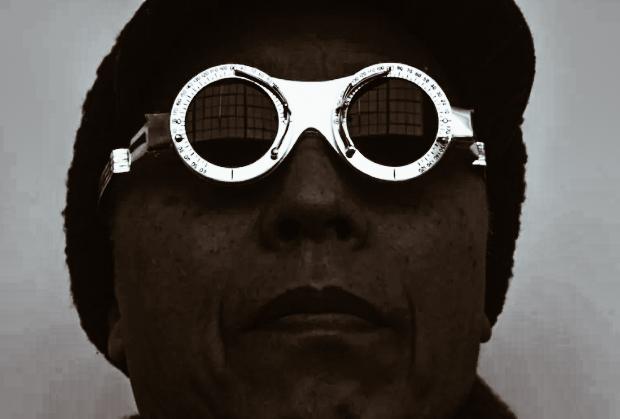
photo credits: artslife.com
Nato nel 1948 a Tokyo, Hiroshi Sugimoto dopo aver conseguito il Bachelor of Arts, si trasferisce a Los Angeles per studiare fotografia. Questi studi lo porteranno, negli anni 70 ad affermarsi come uno dei più famosi fotografi contemporanei.
I suoi lavori trattano della storia e dell’esistenza temporale, investigando su temi quali il tempo, l’empirismo e la metafisica. Sugimoto ha ricevuto numerosi grant e le sue opere sono esposte nelle collezioni della Tate Gallery, del Museum of Contemporary Art, Chicago, del Metropolitan Museum di New York e del Guggenheim di New York.
Come molti degli artisti contemporanei, anche Sugimoto ha collaborato con la moda, questa volta con la casa francese Hermès. Le foto a colori di Sugimoto per i foulards di Hermes sono state esposte nel giugno 2012 al Museo delle culture di Basilea. Durante la Biennale di Venezia del 2014, Sugimoto ha svelato la sua “Glass Tea House Mondiran” presso Le Stanze del Vetro sull’isola di San Giorgio Maggiore.
Il mondo dell’arte è ricco di sfaccettature date da ispirazioni continue, dalla ricerca dell’io, dalla necessità di esprimere concetti profondi senza l’utilizzo di parole. Quali tra gli artisti contemporanei giapponesi vi hanno più colpito? Fatecelo sapere nei commenti!











